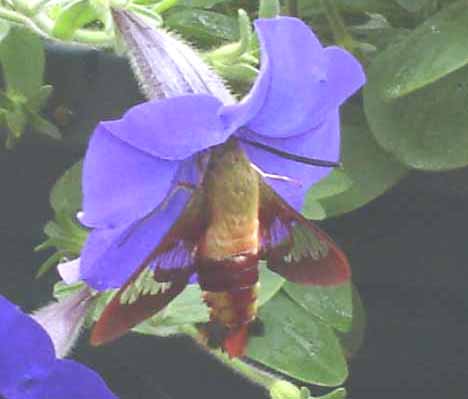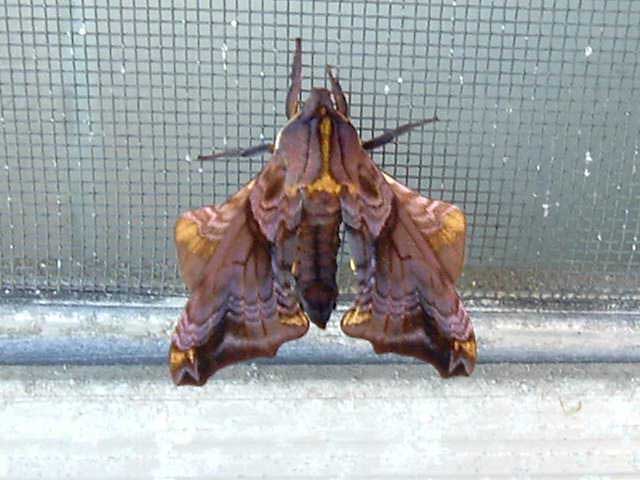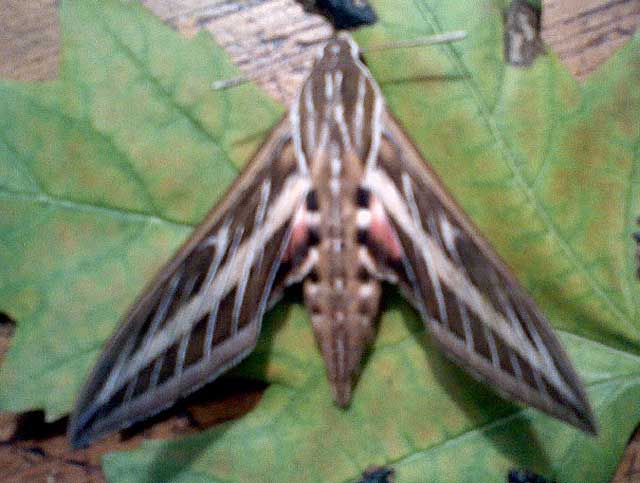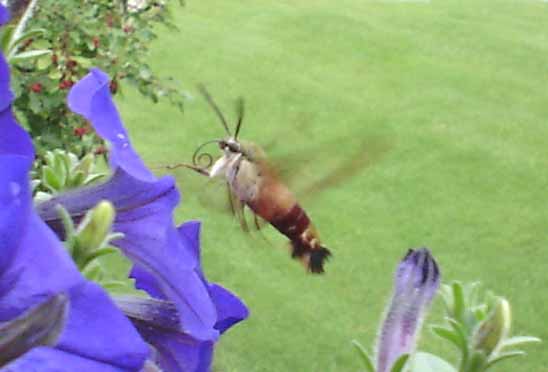Oakland County
Sphingidae

Hemaris thysbe, July 18, 2005, courtesy of Diane Smith
|
|
Created/dedicated as per personal communication with Diane Smith (Hemaris thybse), July 18, 2005 Updated as per personal communication with Kimberly Strawska Hackett (Paonias myops), July 17, 2008 Updated as per James P. Tuttle's The Hawk Moths of North America, July 1, 2009 Updated as per personal communication with Mary Healey (Hyles lineata), October 4, 2013 |

It is hoped that this checklist, with the thumbnails and notes, will help you quickly identify the moths you have encountered.
A WO" after the species name indicates that I have no confirmed reports of this species in Oakland County, but I (William Oehlke) expect that this moth is present.
This page is inspired by and dedicated to Diane Smith who sent me the images of Hemaris thysbe on this page.
Special thanks goes to Kimberly Strawska Hackett who took the following picture of a Paonias myops resting on her neighbour's screen door on July 17, 2008.

Paonias myops male (note curved abdomen), Oakland County, Michigan,
July 17, 2008, courtesy of Kimberly Strawska Hackett.
Please also send your sightings to BAMONA, an excellent online resource which has replaced USGS.
Many thanks to Mary Healey who provides the following image of Hyles lineata.

Hyles lineata, Birmingham, Oakland County, Michigan,
October 4, 2013, courtesy of Mary Healy.
Visit Michigan Catocala: Underwing Moths.
Sphinginae subfamily
Smerinthini Tribe:
Macroglossinae subfamilyDilophonotini Tribe:
See Hemaris comparison to help distinguish the next three species.
Philampelini Tribe:
Macroglossini Tribe:
|

Both Diane and I got a chuckle over the seeming appearance of sun glasses on this visitor to her flowers! Perhaps its on its way to the 'Oscars'.
Enjoy some of nature's wonderments, giant silk moth cocoons. These cocoons are for sale winter and fall. Beautiful Saturniidae moths will emerge the following spring and summer. Read Actias luna rearing article. Additional online help available.
Eggs of many North American species are offered during the spring and summer. Occasionally summer Actias luna and summer Antheraea polyphemus cocoons are available. Shipping to US destinations is done from with in the US.
Use your browser "Back" button to return to the previous page.
This page is brought to you by Bill Oehlke and the WLSS. Pages are on space rented from Bizland. If you would like to become a "Patron of the Sphingidae Site", contact Bill.
Please send sightings/images to Bill. I will do my best to respond to requests for identification help.
 Show appreciation for this site by clicking on flashing butterfly to the left. The link will take you to a page with links to many insect sites. |
I very much appreciate all the many images that have been sent to me, or of which I have been granted permission to copy and post from other websites. All images on this site remain the property of respective photographers.
If you would like to contribute to the maintenace of this website by sending a contribution to
Bill Oehlke
Box 476
155 Peardon Road
Montague, Prince Edward Island, C0A1R0
Canada
your donation would be much appreciated and would be used for
1) paying for webspace rental;
2) paying for computer maintenance and software upgrades;
3) purchases of additional text reference material (journals and books) in anticipation of expanding the site to a worldwide Sphingidae site;
4) helping to pay my daughter's tuition (completed spring of 2013); with anything left over going to humanitarian aid.
If you are mailing a check from USA, please use $1.10 (2013 rate) postage. Donations can also be made through Paypal via the button below.